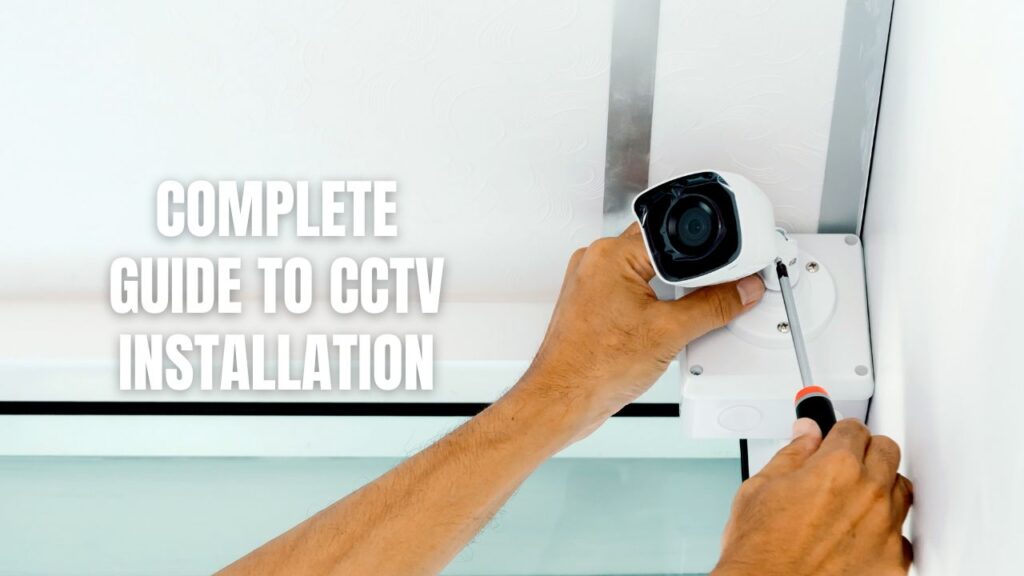Installing a CCTV camera system can seem daunting, but with this step-by-step guide you’ll learn everything you need to know about CCTV installation and setting up security cameras in your home or business.
What is CCTV?
CCTV stands for closed-circuit television. It is a video surveillance system that uses cameras to transmit footage to a specific set of monitors or digital video recorders. CCTV systems are commonly used for security purposes to deter crime and monitor property.
Why Install CCTV Cameras?
There are many benefits to installing CCTV security cameras:
- Deter crime – Studies show that properties with visible security cameras have significantly reduced crime rates. Criminals don’t want to be identified on camera.
- Monitor your property – Keep an eye on your home, business, parking lots, etc. You can view footage remotely on your smartphone.
- Peace of mind – CCTV cameras provide 24/7 monitoring for added security and safety.
- Evidence – CCTV footage can provide evidence in the event of a crime or accident on your property.
Types of Security Cameras
There are a few main types of security cameras to choose from when installing a CCTV system:
Wired Security Cameras
- Connect via cables to the digital video recorder (DVR)
- Provide reliable, high quality video
- Require wiring installation
Wireless Security Cameras
- Connect wirelessly via WiFi to the DVR
- Easy to install without wiring or cables
- Work best within 300 feet range of WiFi router
IP Cameras
- Connect via internet protocol to network video recorder (NVR)
- Can be accessed remotely through internet
- High resolution with smart features
CCTV Installation Step-by-Step
Follow this CCTV installation guide to properly set up security cameras:
1. Plan Camera Placement
- Survey the area and decide where cameras should be positioned.
- Consider camera range and field of view for optimal coverage.
- Cameras should be installed in high vantage points if possible.
2. Install Cameras
- Attach mounting hardware to surface where camera will be fixed.
- Attach camera securely to mounting brackets.
- Adjust position and angle to optimize camera view.
3. Run Cables
- For wired cameras, run video and power cables from each camera to the DVR.
- Use cable conduits to protect and hide wires.
4. Connect Cameras to DVR
- Connect video and power cables from cameras to video inputs on DVR.
- Wireless cameras connect directly to WiFi without cables.
5. Connect DVR to Monitor
- Use a video cable like HDMI to connect DVR to a monitor.
- View live camera feeds on the monitor.
6. Configure Camera Settings
- Access DVR menu and configure each camera’s video settings.
- Adjust resolution, frame rate, etc.
7. Set up Remote Viewing
- Download app on smartphone to view cameras remotely.
- Or port forward DVR to allow remote internet viewing.
And that covers the basic CCTV installation process! It’s best to have professional CCTV installers handle the setup, but you can install DIY security cameras if you’re handy. Just make sure to test cameras and connections thoroughly.
Tips for Installing Security Cameras
Follow these tips when installing CCTV cameras:
- Place cameras high up for wider field of view
- Angle cameras to capture faces and license plates
- Avoid pointing cameras into sunlight
- Use sturdy mounting hardware for outdoor cameras
- Install cameras in sheltered spots if outdoors
- Use weatherproof housings and conduits where needed
- Post warning signs to deter crime
- Have at least one camera covering each entry point
- Overlap fields of view between cameras
- Light the area properly for night vision cameras
Wired vs Wireless Security Cameras
Deciding between wired or wireless security cameras comes down to pros and cons:
Wired Security Cameras
Pros:
- Reliable with no interference
- Higher video resolution
- Unlimited cable runs
Cons:
- More expensive installation
- Cables must be hidden or secured
Wireless Security Cameras
Pros:
- Quick and easy installation
- Flexible positioning
- No cables required
Cons:
- Lower resolution video
- Limited wireless range
- Signal interference issues
So in summary, wired cameras provide better performance while wireless cameras are simpler to install. Mixing both systems gives you the best of both worlds.
How Do Security Cameras Work?
Security cameras have a lens to capture images, and a sensor that converts those images to video signals. The video footage is then transmitted either over cables or wirelessly to the recording device.
- Analog Cameras – Convert light into analog signals along coaxial cables to DVR
- IP Cameras – Digital video compressed and sent over IP network to NVR
- Wireless Cameras – Digitally transmit footage over WiFi frequencies
The DVR or NVR receives the video signals and records them to a hard drive for viewing and backup. Smart features like motion detection and night vision are also built into security cameras.
Why You Need CCTV Installation
Trying to install a complex CCTV system yourself can be extremely difficult and risky. That’s why it’s highly recommended to hire professional CCTV installers.
Here are some key reasons you need CCTV installation services:
- Expert knowledge – They’re familiar with all equipment, configurations and setup needs
- Correct setup – Professionals will install the system properly the first time
- Saving time – CCTV installation can take days which is time consuming
- Neat cabling – Cables will be neatly run and concealed
- Testing and commissioning – Extensive testing to ensure cameras work
- Warranties – Professional installation provides workmanship warranties
- Maintenance – Many companies provide ongoing CCTV maintenance
So rather than fumbling through a DIY camera setup, get the job done right by the professionals.
Where To Put CCTV Cameras?
CCTV cameras should be placed in locations that cover entry and exit points, high-traffic areas, and any vulnerable spots on a property. Ideal positions are overlooking building entrances, parking lots, cash registers, and warehouses. Cameras should also be angled to capture faces and license plates clearly.
How Many CCTV Cameras Do I need?
The number of CCTV cameras needed depends on the size and layout of the area needing surveillance, the camera capabilities and features, and the budget. A general guideline is 1 camera covering every 10-15 feet for interior spaces and 1 camera per 20-35 feet on exteriors. High-risk areas need more density. Home systems need 4-8 cameras while businesses may need 10-20 cameras or more for comprehensive coverage.
CCTV Installation Costs
The cost to install CCTV cameras can range greatly based on different factors:
- System size – Number of cameras needed and area coverage
- Camera types – Simple vs high resolution IP cameras
- Installation complexity – Cabling needs, conduit, labor time
- Additional hardware – Monitors, mounts, software etc.
- Professional installation – Service fees and maintenance packages
For a small home system with 4 security cameras, total costs usually range from $500 – $1500.
Larger business installations with multiple high-end cameras, extensive cabling, and remote access features can cost anywhere from $2,000 up to $10,000 or more.
Keep in mind that professionally installed systems often come with warranties, maintenance and full service support.
Choosing a CCTV Installation Company
If you want to have CCTV cameras installed at your property, here are some tips for choosing the right company:
- Check reviews – Pick an established company with overwhelmingly positive customer reviews.
- Compare quotes – Get quotes from 3-5 installers to find the best rate for your needs.
- Look for experience – Search for a company with extensive CCTV installation experience.
- Verify licensing – Make sure the company is properly licensed for security installations.
- Choose local – A local provider can offer faster support and maintenance.
- Check reputation – Select a reputable company known for quality and service.
- Get a warranty – Opt for a company that provides a warranty on parts and labor.
Doing the proper research will ensure you find the ideal CCTV installation company for your surveillance camera needs and budget.
Conclusion
Installing CCTV security cameras requires carefully mounting cameras, running cabling, connecting to recording devices, and configuring optimal camera settings.
While DIY installation is possible for basic camera systems, it’s highly advisable to hire professional CCTV installers. Their expertise allows for a seamless installation process and ensures your cameras are set up correctly.
CCTV installation costs vary based on system size, camera types, and service fees. With some planning and research, you can find an affordable CCTV installation company to properly outfit your property with a surveillance camera system for added security and peace of mind.











